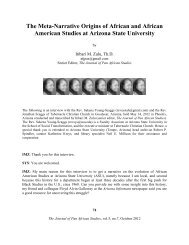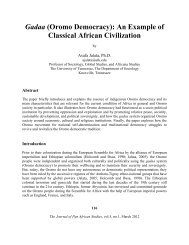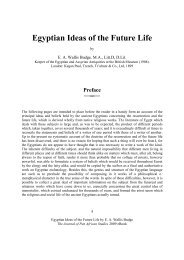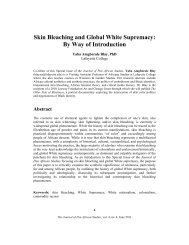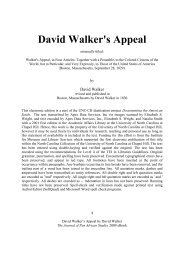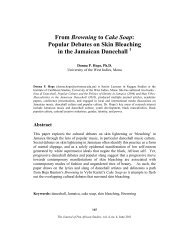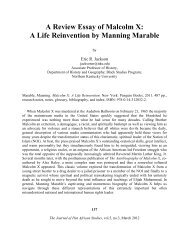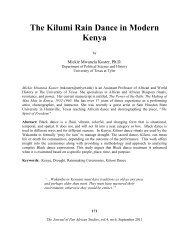The Adaptation of Swahili Loanwords From Arabic - Journal of Pan ...
The Adaptation of Swahili Loanwords From Arabic - Journal of Pan ...
The Adaptation of Swahili Loanwords From Arabic - Journal of Pan ...
Create successful ePaper yourself
Turn your PDF publications into a flip-book with our unique Google optimized e-Paper software.
Input: asl<br />
Output: asili<br />
/asl/ → asili<br />
Input: / asl / *COMPLEX NOCODA DEP-IO ONSET<br />
a. asl *! * *<br />
b. a.sil *! * *<br />
c. � a.si.li * * *<br />
d. as.i.li *! * * * *<br />
Although Polome (1967) and Batibo (1996) acknowledge the existence <strong>of</strong> consonant clusters at<br />
the onset <strong>of</strong> borrowed words and give examples like stempu /stɛ.mpu/ “stamp’ and stovu<br />
/sto.vu/ “stove’, I did not get any such examples <strong>of</strong> word initial onset consonant cluster in the<br />
data. Also, procedurally we know that an epenthetic vowel breaks up clusters <strong>of</strong> two consonants<br />
at the beginning <strong>of</strong> a word, as well as clusters <strong>of</strong> three consonants in medial position. A medial<br />
cluster <strong>of</strong> two consonants is not broken up by epenthesis, as this can be split between two<br />
syllables without the need for a complex margin: where the first consonant syllabifies as a simple<br />
coda, and the second as a simple onset. This has proved problematic in Kiswahili when it adapts<br />
a loanword with a medial consonant cluster (CC) because it prefers open syllables to closed<br />
syllables. In fact, Polome (1967:50) says that in words <strong>of</strong> Bantu stock, consonant sequences are<br />
always tautosyllabic, as in /ma.mba/ ‘crocodile’ and /ku.bwa/ ‘big’. He, however, adds that in<br />
loanwords the syllable boundary usually lies after the first two consonants, for example.,<br />
between /l/ and /t/ in sultani , but in colloquial speech, this syllable-final consonant is <strong>of</strong>ten<br />
released with a short vowel, thus tending to re-establish the Bantu pattern <strong>of</strong> syllabification, for<br />
example., labda ‘perhaps’ /la.bu.da/ or ratli ‘pound’, also becomes /ra.ti.li/. I will use the word<br />
sultani to illustrate my point.<br />
(8) Input: sulta:n<br />
Output: sultani<br />
Let us try to syllabify the word sultani.<br />
(i) Write the word “sultani” and link the letters to C or V forms as appropriate.<br />
(9) C V C C V C V<br />
│ │ │ │ │ │ │<br />
s u l t a n i<br />
52<br />
<strong>The</strong> <strong>Journal</strong> <strong>of</strong> <strong>Pan</strong> African Studies, vol.2, no.8, March 2009



